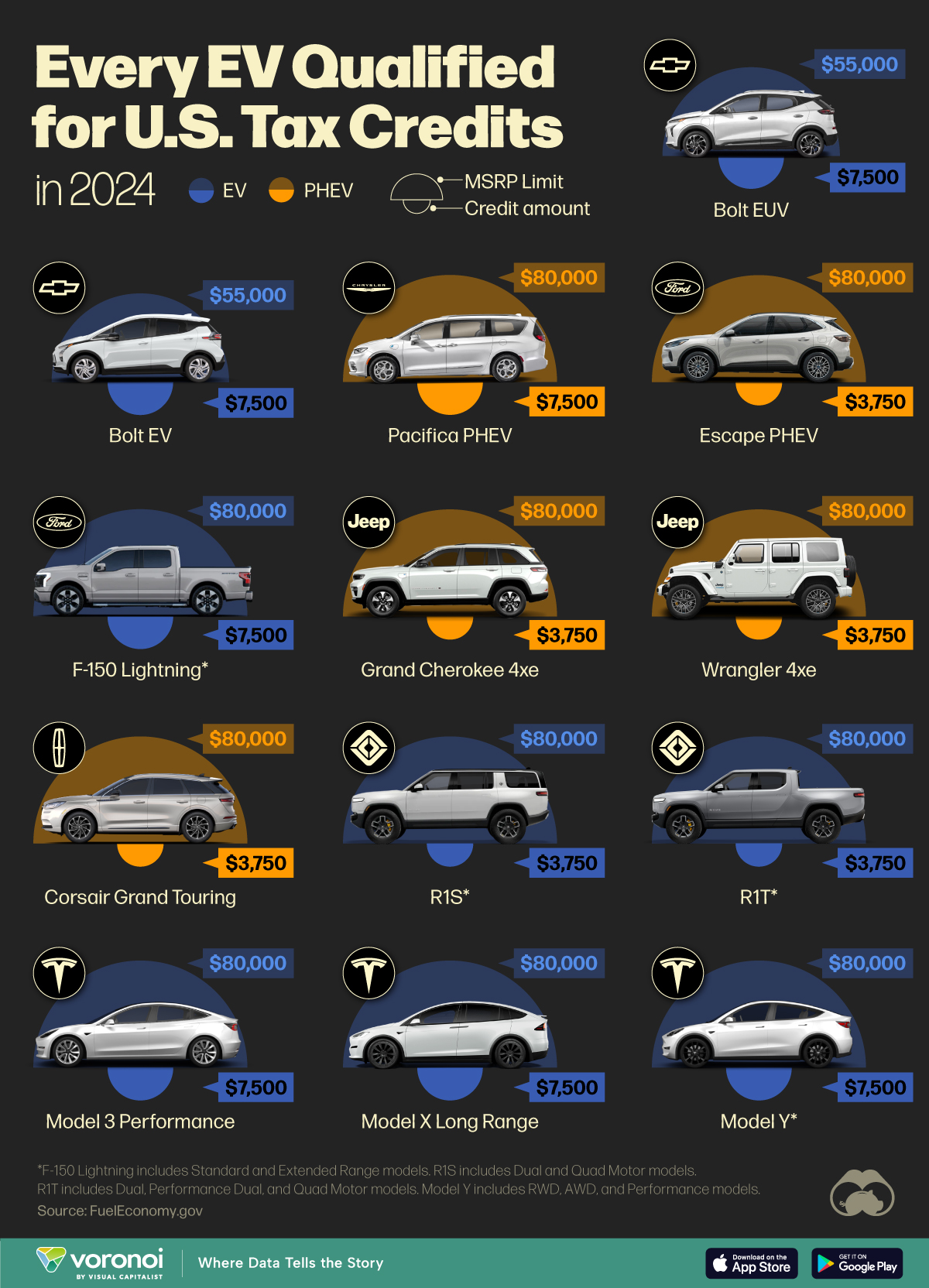![]()
See this visualization first on the Voronoi app.

Every EV Qualified for U.S. Tax Credits in 2024
This was originally posted on our Voronoi app. Download the app for free on iOS or Android and discover incredible data-driven charts from a variety of trusted sources.
This year, the list of qualified electric vehicles (EVs) for U.S. tax credits is relatively small.
Many popular models like the Nissan Leaf, Ford Mustang Mach-E, and some Tesla Model 3s are missing—largely due to new battery sourcing rules. With stricter rules coming into effect, the number of models is dropping from 43 to 13.
This graphic shows the qualifying EV models in 2024, based on data from FuelEconomy.gov.
Which EVs Made the List?
Here are the EVs that are eligible for a U.S. tax credit of up to $7,500 at the point of sale:
| Car | Vehicle Type | Credit Amount | Manufacturer's SuggestedRetail Price Limit |
|---|---|---|---|
| Chevrolet Bolt EUV | EV | $7,500 | $55,000 |
| Chevrolet Bolt EV | EV | $7,500 | $55,000 |
| Chrysler Pacifica PHEV | Plug-in Hybrid | $7,500 | $80,000 |
| Ford Escape PHEV | Plug-in Hybrid | $3,750 | $80,000 |
| F-150 Lightning* | EV | $7,500 | $80,000 |
| Jeep Grand Cherokee 4xe | Plug-in Hybrid | $3,750 | $80,000 |
| Jeep Wrangler 4xe | Plug-in Hybrid | $3,750 | $80,000 |
| Lincoln Corsair Grand Touring | Plug-in Hybrid | $3,750 | $80,000 |
| Rivian R1S* | EV | $3,750 | $80,000 |
| Rivian R1T* | EV | $3,750 | $80,000 |
| Tesla Model 3 Performance | EV | $7,500 | $80,000 |
| Tesla Model X Long Range | EV | $7,500 | $80,000 |
| Tesla Model Y* | EV | $7,500 | $80,000 |
*F-150 Lightning includes Standard and Extended Range models. R1S includes Dual and Quad Motor models. R1T includes Dual, Performance Dual, and Quad Motor models. Model Y includes RWD, AWD, and Performance models.
The good news is that getting the discount is now easier for customers.
Instead of filling out tax paperwork to receive the tax credit, buyers will automatically get the discount at participating dealerships at the time of purchasing.
Additionally, models eligible for a partial credit of $3,750 include Rivian EVs along with plug-in hybrids from Jeep, Ford, and Lincoln.
Ultimately, the tax credit is designed to encourage people to switch to EVs and purchase models that are sourced in America. Overall, it is part of a wider plan to boost manufacturing and clean energy investment across the country.
U.S. EV Manufacturing Push
Several automakers are ramping up investment in American battery plants.
In October 2023, Toyota announced it was investing an additional $8 billion in its North Carolina battery plant, adding 3,000 new jobs.
Along with this, Ford is constructing a 3,600 acre facility for battery manufacturing and EV production, valued at $5.6 billion. By 2026, it is targeting to make 500,000 electric trucks annually. Located in Tennessee, the mega-campus is set to create 6,000 new jobs.
Still, Ford is scaling back EV investment, citing a reluctance among customers to pay a premium for electric models. The United Auto Workers deal, estimated to cost Ford $8.8 billion, likely impacted EV investment plans.
The cost of EV batteries can range from around $8,000 to over $22,000.
Automakers including Lucid, General Motors, Honda, Nissan, and Stellantis (Chrysler’s parent company) are all building, or plan to build, battery facilities in the country.
The post Every EV Qualified for U.S. Tax Credits in 2024 appeared first on Visual Capitalist.